Assumption of the Virgen Ap Art History Quizlet P L
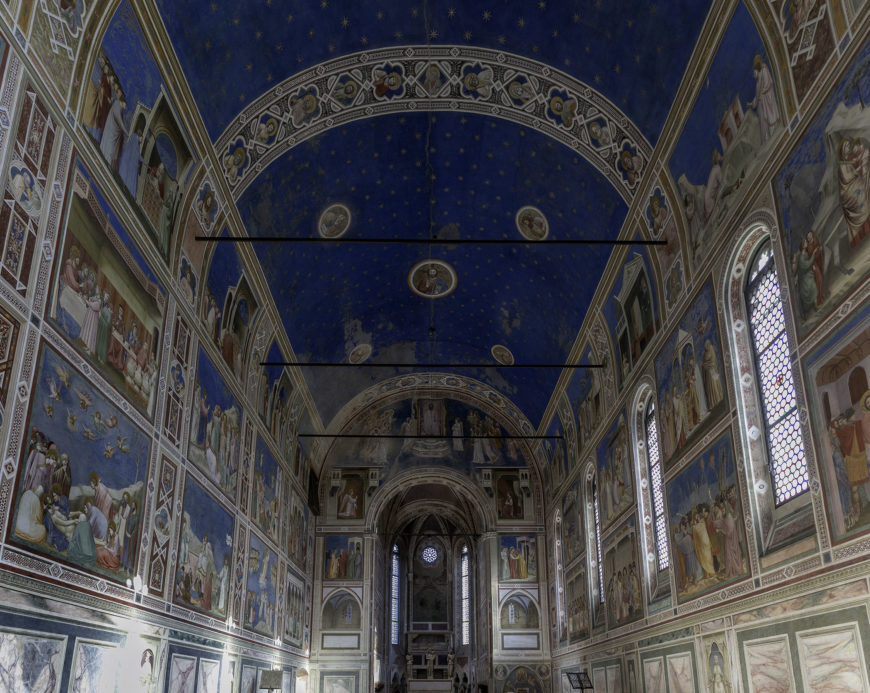
Fresco bike by Giotto, Arena (Scrovegni) Chapel, Padua, c. 1305 (photo: Steven Zucker, CC BY-NC-SA two.0)
Late medieval or proto-renaissance?
The Renaissance does not have a start date. Its origins are often located around 1400 but equally early as the late 1200s nosotros see changes in painting and sculpture that lay the foundation for what we will come to recognize as the Renaissance. Some scholars telephone call this early on period the "Late Gothic"—a term which refers to the late Heart Ages, while other people call it the "Proto-Renaissance"—the beginnings of the Renaissance. In any example, a revolution is first to take identify in Italy the early 1300s in the way people retrieve about the earth, the way they think about the by, and the way they think about themselves and their relationship with God.
Giotto
The creative person who takes the biggest stride away from the medieval style of spiritual representation in painting in the early 14th century is Giotto.
Giotto is mayhap best known for the frescoes he painted in the Arena (or Scrovegni) Chapel. They were commissioned by a wealthy man named Enrico Scrovegni, the son of a well-known banker (and a banker himself). According to the Church, usury (charging involvement for a loan) was a sin, and and then maybe one of Enrico's motivations for building the chapel and having it busy by Giotto was to atone for the sin of usury. The chapel is known as the Arena Chapel since information technology is on the site of an ancient Roman arena (or amphitheater) that later became the property of Scrovegni, whose palace abutted the chapel (the palace was torn down in the nineteenth century, though parts of the arena remain).
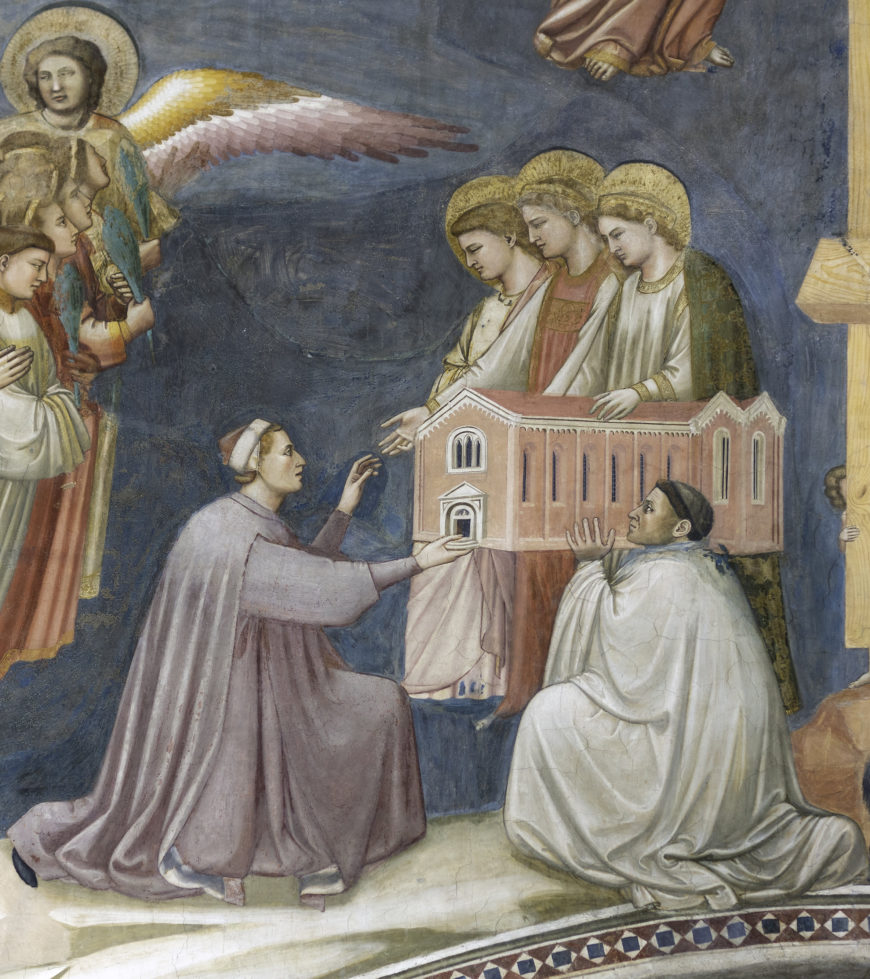
Enrico Scrovegni assisted by a priest, presents the chapel to the Virgin Mary and ii other figures (detail), Giotto, Last Judgment, c. 1305, fresco cycle (Loonshit (Scrovegni) Chapel, Padua, Italy; photo: Steven Zucker, CC By-NC-SA 2.0)
Commissioning works of fine art for churches was a common way of doing "skilful works" which could aid you earn your fashion into Sky. We can see Enrico himself in the fresco of the Last Judgment on the west wall of the Loonshit Chapel—he is shown on the side of the blessed (or the elect, those whom Christ has chosen to go to Sky). He is depicted kneeling, presenting the chapel to the Virgin Mary and ii other figures (variously identified). [1]
The photograph at the top of the folio gives united states a sense of what information technology feels like to exist a tourist visiting the Arena Chapel. Because frescoes are painted straight on the wall, they can't easily be moved and put in a museum. Most frescoes are therefore still in the spaces that the artists created them in and that the patrons commissioned them for. Having the work of art in its original context helps usa to understand its meaning for the people of the 14th century.
Looking at the photograph, you lot can encounter that in that location are numerous carve up images in the chapel. The frescoes tell the story of the lives of Mary (beginning with her parents, Joachim and Anna) and Christ on the long walls. Past the altar, Giotto painted the Proclamation, and at the other end, on the entrance wall, the Concluding Judgment.
Rather like a comic book without words, Giotto tells the story of Christ and his parents through pictures. Near of the population of Europe was illiterate at this fourth dimension and and then couldn't read the Bible for themselves (Bibles were rare and expensive in any case—in that location was no press press and and so each was copied by hand). People learned the stories of the Bible—stories that would help them get to heaven—by hearing the words of the priest in the church, and by looking at paintings and sculptures.
Notes:
[1] In 1 estimation, the nearest figure is the Annunciate Virgin, the eye figure is Saint Mary of Charity (so the two important roles Mary plays in the chapel), and the last figure is the Angel Gabriel. Some other source identifies these additional figures as St. John the Evangelist and Mary Magdalene. These figures have too been identified every bit the Virgin Mary, the Virgin of Charity and the Virgin Advertise.
Additional resources:
Smarthistory video on the Arena Chapel (Office one of 4)
Smarthistory video on the Arena Chapel (Part ii of 4)
Smarthistory video on the Arena Chapel (Office 3 of 4)
Smarthistory video on the Arena Chapel (Part 4 of 4)
Official site of the Arena Chapel
Dr. Allen Farber's page on the Arena Chapel
Smarthistory images for teaching and learning:
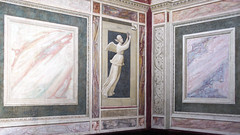
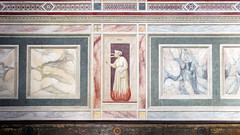
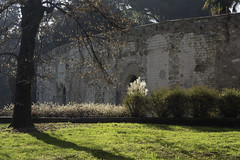
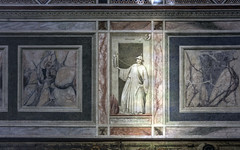
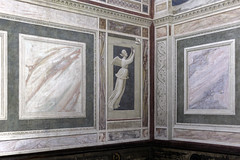
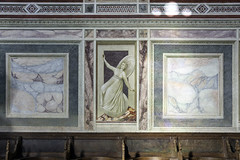
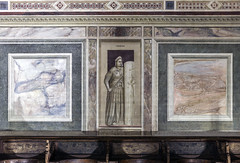
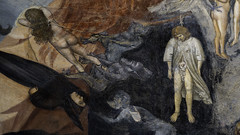
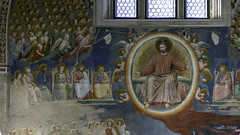
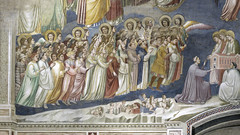
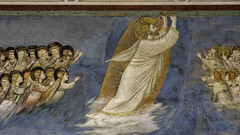
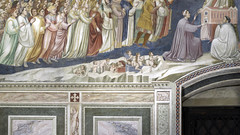
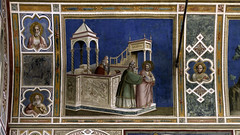
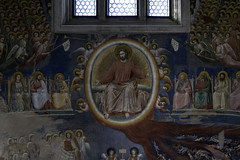
More than Smarthistory images…
Source: https://smarthistory.org/giotto-arena-scrovegni-chapel/